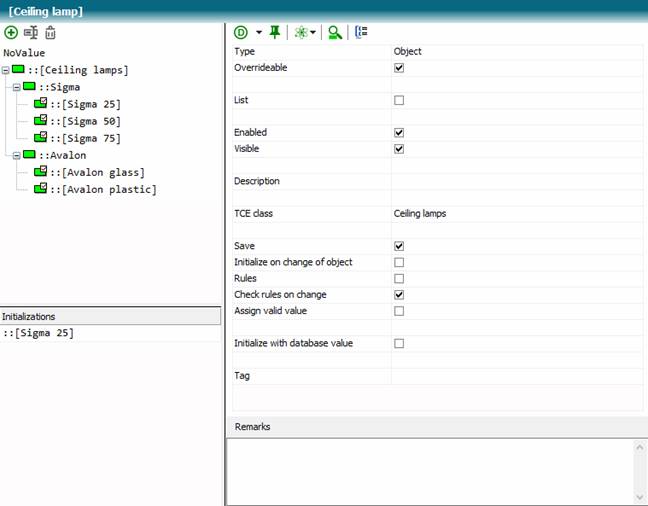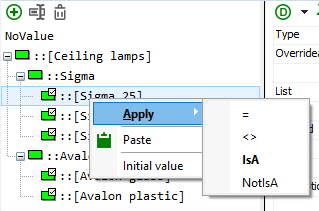
An object is created from a class at run time. An object definition is made below the item “ordered objects” or below “Features or unordered objects” or a feature group defined here.


|
Property |
Description |
|
Type |
Always „Object“ |
|
Overrideable |
If the switch is set, the structure element can be overridden in derived classes. |
|
List |
If the switch is set, the variable manages a list. A list item is addressed via a numeric index. The smallest index is 0 (zero). |
|
Enabled |
If the switch is not set, an expression can be declared to define the activation. |
|
Enabled expression |
Expression to define the activation. Many controls use this expression to set the activation. |
|
Visible |
If the switch is not set, an expression can be declared to define the visibility. |
|
Visible expression |
Expression to define the visibility. Many controls use this expression to set the visibility. |
|
Description |
An expression for the multilingual name of the variable. Here, for example, a text constant can be entered. |
|
TCE class |
Name of a class defining the type of objects which can be created by this variable. |
|
Save |
If the switch is set, the objects created with this variable will be saved with serialization of the object structure. |
|
Initialize on change of object |
If the parent object of an object of this class will be changed to another object, this variable will be newly initialized. |
|
Rules |
The object can have rules when this switch is set.
This changes the examination behavior:
Without setting the switch, the object can be initialized by any class derived from TCE class or can be left uninitialized (NoValue). If the switch is set, the class of an object of this variable must be declared valid or even the value NoValue has to. |
|
Check rules on change |
If the switch is set, all rules of the running application will be checked, when a new object will be created in this variable. |
|
Initialize with database value |
If the variable is defined inside a class which is accessing ODBC child classes, the variable can be initialized by a value of one column of the ODBC select statement. |
|
DB column |
Name of the column defining the database initialization. |
|
Tag |
Freely defineable string data fort he variable. |
|
Remarks |
Developer comments. |
Initializations

Example of an initialization for a non-list object (scalar object)
Objects will be initialized with a valid class name, which has to be equal or derived from the definition class (TCE class) of the variable.
Class names can be specified in several ways:
'Sigma 25'
"Sigma 25"
"Sigma" & " " & "25"
::"Sigma 25"
::[Sigma 25]
or with class names without spaces and special characters
::Sigma
|
Property |
Description |
|
Index |
For non scalar variables a list index has to be defined for an initialization. The lowest possible index is Null (0). Multiple initializations can be specified. The indexes do not have to be complete. For example, indexes can be 10, 20, 30. |
Decision
 By
clicking on the symbol, a new value decision can be created for the
variable.
By
clicking on the symbol, a new value decision can be created for the
variable.
Defining valid values

When the Rules switch is set, the valid classes can be selected from the context menu of the object's class view (classes from the object's definition class).
|
Action |
Description |
|
Apply |
Different operators can be selected.
= Only the class with exactly this class name is a possible class.
<> The class with the class name is not a possible class.
Isa The classes and their derived classes are possible classes.
NotIsa The class and its derived class are not possible classes.
|
|
Paste |
A previously copied simple expression can be inserted as a class term. |
|
Initial value |
The class is added to the list of initializations. |